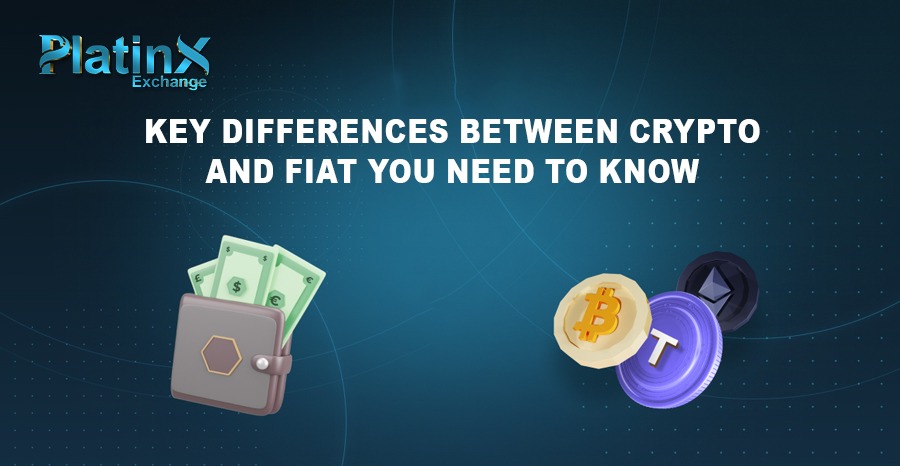If you are new to the world of digital currencies, you might be wondering what are the differences between cryptocurrency and fiat currency. Both serve as mediums of exchange, but they have distinct features, advantages, and disadvantages. In this blog post, we will explore the key differences between crypto and fiat, and how they impact the way we manage our finances.
What Is Fiat Currency?
Fiat currency is the term used to describe the traditional government-issued money that we use every day, such as the US dollar, the euro, or the Indian rupee. The word “fiat” comes from the Latin phrase “let it be done”, meaning that the currency has value simply because the government declares it as legal tender. Fiat currency is not backed by any physical commodity, such as gold or silver, but by the trust and faith of the people who use it.
What Is Cryptocurrency?
Cryptocurrency is a digital asset that derives its value from its native blockchain, which is a decentralized network of computers that store and verify transactions. Cryptocurrency is created and controlled by code and algorithms, rather than by central authorities. Cryptocurrency users can send and receive payments directly, without intermediaries, using cryptographic keys and addresses. Some of the most popular cryptocurrencies include Bitcoin, Ethereum, and Binance Coin.
Key Differences Between Crypto and Fiat
There are several key differences between crypto and fiat, such as:
- Supply: Fiat currency has an unlimited supply, meaning that the government can print more money whenever it wants. This can lead to inflation, which reduces the purchasing power of the currency over time. Cryptocurrency, on the other hand, has a limited supply, meaning that there is a fixed amount of coins that can ever be created. This can create scarcity, which increases the demand and value of the currency over time.
- Governance: Fiat currency is governed by central authorities, such as central banks and government institutions. These authorities have the power to regulate the supply and value of the currency, as well as to impose rules and restrictions on its use. Cryptocurrency is governed by blockchain protocols, code, and communities. These entities have the power to determine the rules and parameters of the network, as well as to propose and implement changes and upgrades. Cryptocurrency users have more freedom and autonomy over their funds, but also more responsibility and risk.
- Transparency: Fiat currency transactions are often opaque and hidden from the public. The central authorities can manipulate the data and records of the transactions, as well as censor or freeze the accounts of the users. Cryptocurrency transactions are transparent and visible to everyone. The blockchain network records and verifies every transaction, and anyone can access and audit the data and records. Cryptocurrency users can enjoy more privacy and security, but also more accountability and scrutiny.
- Accessibility: Fiat currency is accessible to anyone who has a bank account or a physical wallet. However, many people around the world are unbanked or underbanked, meaning that they do not have access to basic financial services and products. Cryptocurrency is accessible to anyone who has an internet connection and a digital wallet. Anyone can create and use a cryptocurrency account, without the need for intermediaries or identification. Cryptocurrency users can benefit from more inclusion and empowerment, but also more complexity and volatility.
Common FAQs About Crypto vs. Fiat
1. What is the difference between cryptocurrency and blockchain?
Blockchain is the technology that underlies cryptocurrencies, acting as a secure and transparent ledger for recording transactions. Cryptocurrency is a digital asset that operates on the blockchain.
2. Is crypto legal?
The legality of crypto varies depending on jurisdiction. Research your local regulations before trading.
3. Is crypto safer than fiat?
Both systems have their security strengths and weaknesses. Crypto offers transparency and decentralized security, while fiat benefits from government-backed infrastructure.
4. What happens if a central bank collapses?
Fiat’s value relies on the issuer’s stability. A central bank collapse could result in currency devaluation and economic instability.
5. Why can’t governments just print more money to solve financial problems?
Excessive money printing can lead to inflation, reducing the purchasing power of the currency.
6. Is fiat currency going to be replaced by crypto?
It’s unlikely that crypto will completely replace fiat shortly. Both systems may coexist and evolve alongside each other.
7. What are the risks of investing in crypto?
The market is volatile, and scams and hacks can occur. Do your research and invest cautiously.
8. Is it hard to buy and use crypto?
Crypto exchanges and wallets have become more user-friendly in recent years. However, it’s still important to understand the technology and potential risks before investing.
9. Will crypto become mainstream?
Crypto adoption is growing, but it still faces challenges like legal uncertainties and volatility. Whether it becomes mainstream remains to be seen.
10. What are some good resources to learn more about crypto?
Recommend credible websites, podcasts, or educational platforms online.
Conclusion
Cryptocurrency and fiat currency are two different types of money that have their pros and cons. Depending on your needs and preferences, you might prefer one over the other, or use both in different situations. The important thing is to understand the differences between them, and how they affect your financial decisions and outcomes. We hope that this blog post has helped you learn more about the key differences between crypto and fiat and that you will continue to explore the fascinating world of digital currencies.

